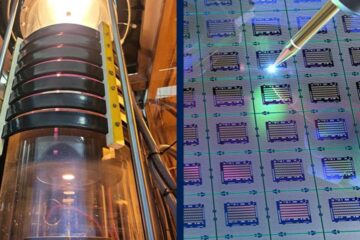MESSENGER Spacecraft to Swing Into Orbit Around Mercury

Scientists are excited about solving some of the mysteries surrounding our smallest and hottest planet. The findings are expected to broaden our understanding of rocky planets, more and more of which are being discovered in other solar systems.
At 8:45 p.m. EDT on March 17, the MESSENGER spacecraft will execute a 15-minute maneuver that will place it into orbit around Mercury, making it the first craft ever to do so, and initiating a one-year science campaign to understand the innermost planet.
Mercury is an extreme among the rocky planets in our solar system: It is the smallest, the densest (after correcting for self-compression) and the one with the oldest surface and largest daily variations in surface temperature and the least explored.
Understanding this “end member” among the terrestrial planets is crucial to developing a better understanding of how the planets in our solar system formed and evolved. MESSENGER stands for MErcury Surface, Space ENvironment, GEochemistry and Ranging.
Along with their collaborators on the MESSENGER mission team, several University of Arizona researchers and technical experts are anxiously awaiting the orbit insertion maneuver, which marks the end of the space probe's six-and-a-half year journey to the innermost planet of our solar system.
One of them is Ann Sprague, a research scientist at the UA's Lunar and Planetary Laboratory. Sprague is looking forward to gathering data with the Mercury Atmosphere and Surface Composition Spectrometer, or MASCS, an instrument aboard the MESSENGER spacecraft capable of analyzing light reflected off the planet's surface and scattered by atoms and ions – atoms with an electric charge – above the surface. Both types of light give scientists clues about the composition of the surface.
“By identifying spectral bands and modeling the results we hope to identify the mineral content of the surface materials and eventually figure out what kind of rocks are covering the surface and have come up from below the surface during volcanic events,” Sprague said.
When MESSENGER streaked into the early morning sky over Cape Canaveral on Aug. 3, 2004, very little was known about Mercury. No spacecraft had approached the planet since the Mariner 10 space probe performed three fly-by maneuvers over the course of 1974 and 1975, imaging the planet's surface. However, Mariner 10 sent back photos of only one side of the planet, leaving the other shrouded in mystery.
One of the mysteries scientists are hoping to solve with the MESSENGER mission surrounds Mercury's magnetic field. At a diameter only slightly larger than that of the moon (about 4,800 kilometers or 2,983 miles), Mercury should have solidified to the core. However, the presence of a magnetic field suggests the planet's innards are partially molten.
For many decades, scientists such as Sprague and her fellow MESSENGER science team members Robert Strom and William Boynton at the UA's Lunar and Planetary Laboratory were confined to studying Mercury by sifting through Mariner 10 data, making ground-based observations using visible and mid-infrared spectroscopy and by studying data obtained from Mars and meteorites.
“I am most excited to see what MESSENGER will discover about Mercury's exosphere,” Sprague said, “because it will tell us a lot about the surface of the planet – what the volatiles, or gases, are in the cold locations and what elements are present in the minerals on the surface.”
Lacking an atmosphere, Mercury is surrounded by an exosphere: an invisible, thin region containing atoms and ions. It is generated by the solar wind's charged particles showering down onto the surface. During the process, various chemical elements are kicked up from Mercury's soil. The heavier ones, like sodium and potassium, remain fairly close to the surface until solar photons push them into space, emanating from the planet as a plume almost like that of a comet, except invisible to the naked eye.
“Lighter atoms like hydrogen quickly escape into space and soon are swimming in a sea of hydrogen that permeates our solar system,” Sprague explained. “So it's a fine balance between what is heavy enough to be retained around the planet and what is so light that it escapes.”
She added: “One quite exciting possibility would be the presence of elemental mercury in the exosphere or on the surface. “We are waiting anxiously to see if we are going to find the spectrographic signal of mercury in Mercury's exosphere.”
During its journey toward Mercury, MESSENGER passed the planet several times, filling in the imaging gaps left by Mariner 10.
Now, the entire planet with the exception of about five percent has been observed. MESSENGER will focus its cameras on getting the best possible images of the remaining portions, mostly in the polar regions.
“This is a bit unfortunate because at the North Pole, the spacecraft will be going very low and the view will be distorted,” Sprague said. “Over the southern pole, the craft will be several thousand kilometers away, causing the image resolution to be poor and distorted as well.”
The polar regions are of great importance, she said, because ground-based radar observations indicate there may be frozen water beneath thin layers of dust in regions where the sunlight never reaches, such as permanently shadowed crater bottoms.
“Alternatively, there may be other exotic volatiles or metals in those dark craters – like mercury, sulfur, sodium chloride or some other substance not thought of or expected. It is exciting and all eyes will be focused on the data that comes back from those polar scans.”
Robert Strom, professor emeritus in the UA's Lunar and Planetary Laboratory, said: “Once in orbit, MESSENGER will image the surface at 250 meters per pixel. At its closest approach, it will even get to a resolution of six meters per pixel. Of course, you can't image a whole planet at this fine resolution. This will be reserved for targets of opportunity – features that MESSENGER images during its surveys and that catch our attention.”
Strom pointed out that the MESSENGER mission is unusual because its main payload is not the instruments, but the fuel needed to slow the spacecraft down.
“Because the journey from Earth to Mercury goes toward the sun, we need a lot of energy to counteract the sun's gravitational pull,” he explained.
To save fuel, the engineers devised a carefully choreographed dance that MESSENGER performs around selected planets: the Earth, the moon and Mercury.
“By having the probe dance around planets, it can take advantage of their gravitational fields to slow its speed,” Strom added. “Even once in orbit around Mercury, the spacecraft will need to burn fuel every few hours or so to prevent the sun's gravitational field from pulling it out of orbit.”
Another great challenge MESSENGER has to cope with is the intense heat due to Mercury's proximity to the sun. At the equator, surface temperatures become hot enough to melt lead. The heat reflected from the planet's surface is so intense that the spacecraft's instruments need to be shielded against the glare.
“The spacecraft is going to go very fast, traveling around the planet every 12 hours,” Sprague explained. “The orbit is highly elliptical to allow the spacecraft to cool down. We couldn't do this with a circular orbit, like around Mars. Everything would just overheat. MESSENGER must swoop in, keeping its sunshade pointed toward the sun, and then it has to swing out far into space so it can cool down.”
Strom added: “The strategy is to have MESSENGER gather data during its close approach and then read the data out and send them back to Earth while the probe is at a safe distance from the scorching planet.”
Scheduled to remain in orbit for a year, MESSENGER will fly around Mercury 730 times. The mission may be extended for another year.
The in-flight preparations for the orbit insertion maneuver began on Feb. 8, when several heaters on the spacecraft were configured to condition the bi-propellant used during the maneuver.
“Similar to pre-heating the diesel engine of a truck or car prior to starting in cold weather to allow ignition and prevent damage to the engine, the MESSENGER team turns on and off different heaters on the spacecraft so that the pressures for each of the two propellants, hydrazine and nitrogen tetroxide, are at the optimum ratio for safe and efficient maneuver execution,” explained Eric Finnegan, MESSENGER systems engineer at the Johns Hopkins University Applied Physics Laboratory in Laurel, Md.
“Here at the UA, specialists including Karl Harshman, Dave Hamara, Mike Fitzgibbons, and Jerry Droege have important jobs to keep the data flowing, constantly checking for errors in electronic codes and correctly parsing the data for the scientists,” Sprague said.
She pointed out that the mission's significance reaches beyond Mercury.
“Now that so many new planets are being discovered around stars in other solar systems, we need to know the effects of space weathering on rocky surfaces so we can accurately interpret telescopic and other remote sensing data we obtain from other rocky or dusty worlds.”
The MESSENGER mission is led by NASA, the Applied Physics Laboratory at Johns Hopkins University and the Carnegie Institution. This article was compiled in part with content from the MESSENGER Mission website (http://messenger.jhuapl.edu).
MEDIA CONTACTS:
P. Campbell
The Johns Hopkins University
Applied Physics Laboratory
web-MESSNewsCenter-contact@jhuapl.edu
240-228-6792
240-228-6123 Fax
D. Brown
NASA Headquarters
dwayne.c.brown@nasa.gov
202-358-1726
202-358-3093 Fax
T. McDowell
Carnegie Institution of Washington
tmcdowell@ciw.edu
202-939-1120
202-387-8092 Fax
D. Stolte
The University of Arizona
University Communications
stolte@email.arizona.edu
520-626-4402
520-626-4121 Fax
Media Contact
More Information:
http://www.arizona.eduAll latest news from the category: Physics and Astronomy
This area deals with the fundamental laws and building blocks of nature and how they interact, the properties and the behavior of matter, and research into space and time and their structures.
innovations-report provides in-depth reports and articles on subjects such as astrophysics, laser technologies, nuclear, quantum, particle and solid-state physics, nanotechnologies, planetary research and findings (Mars, Venus) and developments related to the Hubble Telescope.
Newest articles

Silicon Carbide Innovation Alliance to drive industrial-scale semiconductor work
Known for its ability to withstand extreme environments and high voltages, silicon carbide (SiC) is a semiconducting material made up of silicon and carbon atoms arranged into crystals that is…

New SPECT/CT technique shows impressive biomarker identification
…offers increased access for prostate cancer patients. A novel SPECT/CT acquisition method can accurately detect radiopharmaceutical biodistribution in a convenient manner for prostate cancer patients, opening the door for more…

How 3D printers can give robots a soft touch
Soft skin coverings and touch sensors have emerged as a promising feature for robots that are both safer and more intuitive for human interaction, but they are expensive and difficult…





















